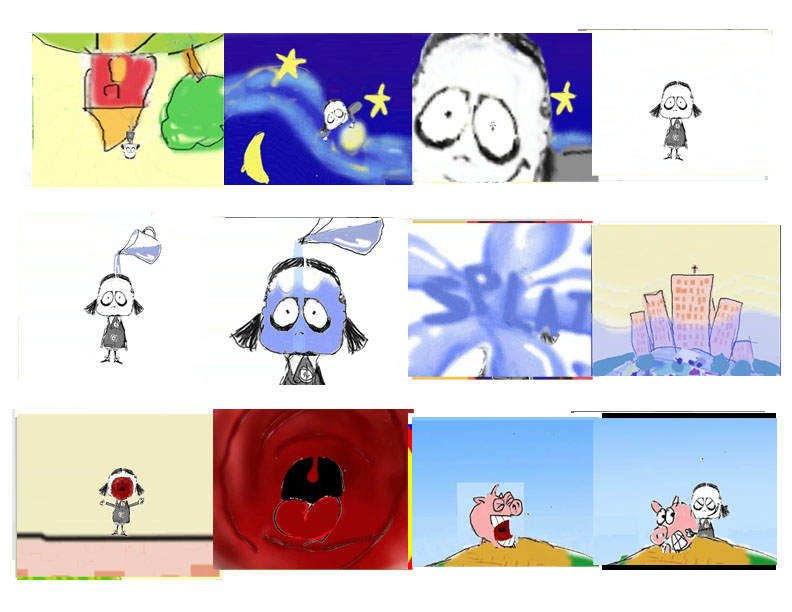 my fuzzy sketch book
my fuzzy sketch book
|
The story of Emeila began with little scribbles and ideas that I drew into the fuzzy sketchbook on your left here. The core idea was to go beyond the
overly hyped photorealism of the Hollywood CGI FX world (where I was working at the time) and explore "painterly-realism" which has its focus not on recreating reality
like a Polaroid camera does, but as a painter would - drawing-out and epitomizing the emotion and meaning of a particular moment or relationship.
More concretely I wanted to go beyond the traditional narrative form of film and explore what Chris Landreth has
called "psycho-realism" where you show the internal thoughts and emotions of a character. If a person emotionally
feels "shattered" then we would see them literally crumble to the floor in shards of broken glass. We see visually
what a character feels and thinks internally.
 some pages from the sketchbook
some pages from the sketchbook
|
An example of this can be seen in something I dubbed "illustratred metaphore". In the narration, the main character Emelia is reflecting on how she
"carried the window inside of her" and visually we see her open her coat, not to reveal a body, but the ribs of a skeleton with a glowing window lodged
where her heart would be. We are not seeing a biological x-ray, but an emotional x-ray - not photorealism, but psychorealism.
Utilizing these methods I set out to tell a story that gives us a look into the thought
world of a 5-year-old Goth girl as she struggles with her own inner
demons. I wanted to weave this "emotional illustration" into the developing narrative as she faces parents and schoolmates,
showing not just what happens to her, but how she sees her world, and how events feel from inside her shoes.

rib scene from story reel
|
Since most animated films - like their live action counterparts - have been based in the traditional narrative structure, there were no roadmaps to go by, which meant I
had to do a lot of experimenting to arrive at how I wanted to tell Emelia's story. I couldn’t really have a "script" since the film largely consisted of images and
illustrated emotion. Instead I had a sketchbook where I cataloged ideas and images which I then worked into story boards.
An invaluable tool here was making a "story reel" (a moving storyboard). This let me see in a rough form whether ideas where working
or not. The process consisted of sketching out storyboards, putting them on the animated story reel, watching them to see how the emotion and timing were
working, then keeping what worked and finessing what didn't. So far I have gone through 10 drafts of the story reel.
To develop a scene I would try to think of the emotional dynamic
of a situation, how it emotionally feels to be there, and then try to epitomize that so the
viewer would recognize this "place" from their own experiences and bring
those feelings into their viewing. Because I was using a method of storytelling that
interwove a traditional narrative with stream of conciousness emotional imagery, I would not only think of situations which epitomized a certain
relationship, but also of images and metaphors that emotionally conduced these feelings.
(c) 2004, All Rights Reserved. "Make Links not Copies"




















 my fuzzy sketch book
my fuzzy sketch book
 some pages from the sketchbook
some pages from the sketchbook

 page from the color story board
page from the color story board